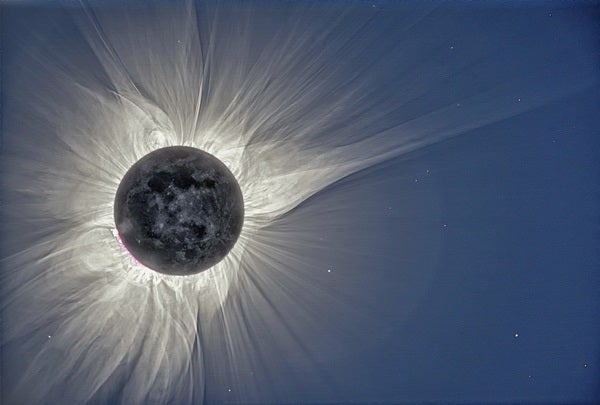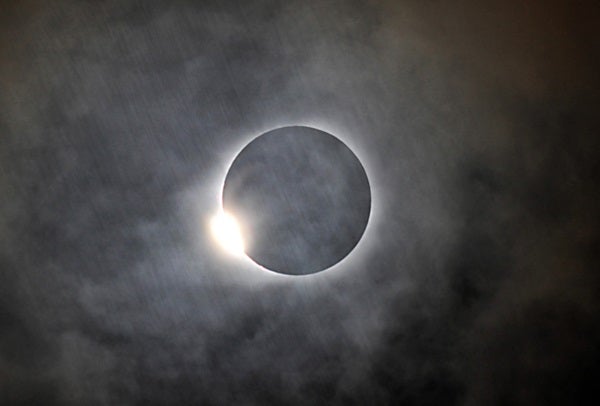Near or far?
During the March 9, 2016, total solar eclipse, I was in a fishing boat off the coast of Ternate, Indonesia, watching totality through a substantially large hole in the clouds. Several times I saw the corona waver ever so slightly like a mirage, and I wondered if my eyes were deceiving me.
It is true that the Sun’s corona is in a dynamic state. But the Sun is so huge that it would take a light flicker a couple of seconds to cross the corona’s brightest parts — not fractions of a second, as occurs with a shimmer.
Therefore, naked-eye coronal shimmering must be a localized phenomenon, with the source being perhaps air turbulence close to the observer, thin atmospheric vapors passing in front of the corona, involuntary motions in the observer’s eyes, or a combination of any or all of these. The flickering I saw reminded me of the passing of shadow bands, except that I saw them cross the “white sheet” of the corona. Before delving into this curious phenomenon further, let’s look at shadow bands as we traditionally see them.
Shadow bands (not every total solar eclipse produces them) are long, alternating bands of light and dark that sweep across Earth like moving waves. Shadow bands are an atmospheric effect caused by light from the Sun’s narrowing crescent interacting with turbulent bundles of air in our atmosphere. These bundles act like lenses to separate the incoming light into moving patterns of constructive (light) and destructive (dark) strips and patches.
Today, observers usually look for shadow bands in the minutes leading up to second contact (the start of totality) or immediately after third contact (the end of totality). But in the 19th century, observers occasionally recorded shadow bands during totality.
For instance, as reported in No. 1294 of Astronomische Nachrichten (the world’s oldest astronomical journal, first published in 1821) during the July 18, 1860, total solar eclipse, Herr C. Haase and Herr Ibach in Valencia, Spain (near the edge of the eclipse’s path), independently observed shadow bands on a nearby tower and its rooftop during totality, noting that the corona also appeared to “undulate violently.” And during the December 22, 1870, totality, Diamilla Muller reported to the Italian Commission that just after the beginning of totality, he saw “undulating shadow bands … moving rapidly over the front of a house.”
Such reports made me wish I had looked down when I saw the corona undulate, to see if shadow bands were visible. But how could they be?
During the July 11, 2010, total solar eclipse that covered Easter Island, Astronomy contributing editor Mike Reynolds imaged shadow bands not on the ground but in thin clouds passing in front of the Sun (though not during totality). Is it possible that shadow bands, hardly noticeable to the eye, could induce the visual wavering of the solar corona as they swept across high, thin clouds?
In his great book The Nature of Light & Colour in the Open Air, Marcel Minnaert tells us that the light of Venus shining through a small opening in a window into a darkened room is enough to create shadow bands — “a wispy cloudiness” that passes over a white wall. Then why shouldn’t the solar corona (especially its bright inner rim), which has the brightness of the Full Moon, be able to produce them? Guess I know what I’ll be looking for come August 21.
As always, send your thoughts to sjomeara31@gmail.com.












